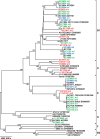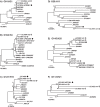Strain-Level Discrimination of Shiga Toxin-Producing Escherichia coli in Spinach Using Metagenomic Sequencing
- PMID: 27930729
- PMCID: PMC5145215
- DOI: 10.1371/journal.pone.0167870
Strain-Level Discrimination of Shiga Toxin-Producing Escherichia coli in Spinach Using Metagenomic Sequencing
Abstract
Consumption of fresh bagged spinach contaminated with Shiga toxin-producing Escherichia coli (STEC) has led to severe illness and death; however current culture-based methods to detect foodborne STEC are time consuming. Since not all STEC strains are considered pathogenic to humans, it is crucial to incorporate virulence characterization of STEC in the detection method. In this study, we assess the comprehensiveness of utilizing a shotgun metagenomics approach for detection and strain-level identification by spiking spinach with a variety of genomically disparate STEC strains at a low contamination level of 0.1 CFU/g. Molecular serotyping, virulence gene characterization, microbial community analysis, and E. coli core gene single nucleotide polymorphism (SNP) analysis were performed on metagenomic sequence data from enriched samples. It was determined from bacterial community analysis that E. coli, which was classified at the phylogroup level, was a major component of the population in most samples. However, in over half the samples, molecular serotyping revealed the presence of indigenous E. coli which also contributed to the percent abundance of E. coli. Despite the presence of additional E. coli strains, the serotype and virulence genes of the spiked STEC, including correct Shiga toxin subtype, were detected in 94% of the samples with a total number of reads per sample averaging 2.4 million. Variation in STEC abundance and/or detection was observed in replicate spiked samples, indicating an effect from the indigenous microbiota during enrichment. SNP analysis of the metagenomic data correctly placed the spiked STEC in a phylogeny of related strains in cases where the indigenous E. coli did not predominate in the enriched sample. Also, for these samples, our analysis demonstrates that strain-level phylogenetic resolution is possible using shotgun metagenomic data for determining the genomic relatedness of a contaminating STEC strain to other closely related E. coli.
Conflict of interest statement
The authors have declared that no competing interests exist.
Figures




References
-
- Feng P. Shiga Toxin-Producing Escherichia coli (STEC) in Fresh Produce—A Food Safety Dilemma. Microbiology spectrum. 2014;2(4):EHEC-0010-2013. Epub 2015/06/25. - PubMed
-
- Feng PC, Reddy S. Prevalences of Shiga toxin subtypes and selected other virulence factors among Shiga-toxigenic Escherichia coli strains isolated from fresh produce. Applied and environmental microbiology. 2013;79(22):6917–23. Epub 2013/09/03. PubMed Central PMCID: PMC3811557. 10.1128/AEM.02455-13 - DOI - PMC - PubMed
MeSH terms
Substances
LinkOut - more resources
Full Text Sources
Other Literature Sources

